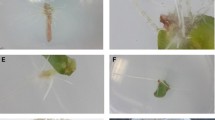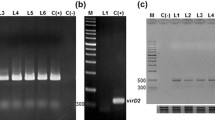Abstract
Differential expression patterns of flavonoid biosynthetic pathway genes in the hairy roots of tartary buckwheat cultivars “Hokkai T8” and “Hokkai T10” were studied over a time course of the light–dark cycle. The Agrobacterium rhizogenes-mediated transformation system was applied for inducing hairy roots. Further, a total of six phenolic compounds and two anthocyanins were analyzed in the hairy roots which were exposed to both light and dark conditions, and their amounts were estimated by HPLC. The gene expression levels peaked on day 5 of culture during the time course of both dark and light conditions. Notably, FtPAL, Ft4CL, FtC4H, FtCHI, FtF3H, FtF3’H-1, and FtFLS-1 were more highly expressed in Hokkai T10 than in Hokkai T8 under dark conditions, among which FtPAL and FtCHI were found to be significantly upregulated, except on day 20 of culture. Significantly higher levels of phenolic compound, rutin, along with two anthocyanins were detected in the hairy roots of Hokkai T10 under both conditions. Furthermore, among all the phenolic compounds detected, the amount of rutin in Hokkai T10 hairy roots was found to be ∼5-fold (59,01 mg/g dry weight) higher than that in the control (12.45 mg/g dry weight) at the respective time periods under light and dark conditions.




Similar content being viewed by others
References
Vogt, T. (2010). Molecular Plant, 3, 2–20.
Clere, N., Faure, S., Martinez, M. C., & Andriantsitohaina, R. (2011). Cardiovascular & Hematological Agents in Medicinal Chemistry, 9, 62–77.
Gresele, P., Cerletti, C., Guglielmini, G., Pignatelli, P., de Gaetano, G., & Violi, F. (2011). The Journal of Nutritional Biochemistry, 22, 201–211.
Sowbhagya, H. B., & Chitra, V. N. (2010). Critical Reviews in Food Science and Nutrition, 50, 146–161.
Winkel-Shirley, B. (2001). Plant Physiology, 126, 485–493.
Ferri, M., Tassoni, A., Franceschetti, M., Righetti, L., Naldrett, M. J., & Bagni, N. (2009). Proteomics, 9, 610–624.
Zhi, L., Jin-Liang, Q., Lu, C., Ming-Sheng, Z., Xiu-Qiang, W., Pang, Y.-J., & Yang, Y.-H. (2006). Plant Cell, Tissue and Organ Culture, 84, 39–46.
Weisshaar, B., & Jenkins, G. I. (1998). Current Opinion in Plant Biology, 1, 251–257.
Hahlbrock, K., & Scheel, D. (1989). Annual Review of Plant Physiology and Plant Molecular Biology, 40, 347–369.
Zhao, J., Zhu, W. H., & Hu, Q. (2001). Plant Growth Regulation, 33, 43–49.
Cooper-Driver, G. A. (2001). Phytochemistry, 56, 229–236.
Li, X., Park, N. I., Xu, H., Woo, S. H., Park, C. H., & Park, S. U. (2010). Journal of Agricultural and Food Chemistry, 58, 12176–12181.
Park, N. I., Li, X., Suzuki, T., Kim, S.-J., Woo, S.-H., Park, C. H., & Park, S. U. (2011). Journal of Agricultural and Food Chemistry, 59, 2356–2361.
Kim, S.-J., Maeda, T., Sarker, M. Z. I., Takigawa, S., Matsuura-Endo, C., Yamauchi, H., Mukasa, Y., Saito, K., Hashimoto, N., Noda, T., Saito, T., & Suzuki, T. (2007). Journal of Agricultural and Food Chemistry, 55, 6314–6318.
Liu, C. L., Chen, Y. S., Yang, J. H., & Chiang, B. H. (2008). Journal of Agricultural and Food Chemistry, 56, 173–178.
Zambryski, P., Tempe, J., & Schell, J. (1989). Cell, 56, 193–201.
Guillon, S. H., Tremouillaux-Guiller, J., Pati, P. K., Rideau, M., & Gantet, P. (2006). Trends in Biotechnology, 24, 403–409.
Murashige, T., & Skoog, F. (1962). Physiologia Plantarum, 15, 473–497.
Timotijevic, G. S., Milisavljevic, M. D., Radovic, S. R., Konstantinovic, M. M., & Maksimovic, V. R. (2010). Journal of Plant Physiology, 167, 61–68.
Li, X., Thwe, A. A., Park, N. I., Suzuki, T., Kim, S.-J., & Park, S. U. (2012). Journal of Agricultural and Food Chemistry, 60, 5629–5635.
Fabjan, N., Rode, J., Koˇsir, I. J., Wang, Z., Zhang, Z., & Kreft, I. (2003). Journal of Agricultural and Food Chemistry, 51, 6452–6455.
Kaitez-Boqata, L. (1988). Fagopyrum, 8, 23–26.
Acknowledgments
We thank Dr. Tastsuro Suzuki of the National Agriculture and Food Research Organization, Hokkaido Agricultural Research Center, for providing tartary buckwheat seeds.
Conflict of Interest
The authors declare that there is no conflict of interest.
Author information
Authors and Affiliations
Corresponding author
Rights and permissions
About this article
Cite this article
Thwe, A.A., Kim, Y., Li, X. et al. Accumulation of Phenylpropanoids and Correlated Gene Expression in Hairy Roots of Tartary Buckwheat under Light and Dark Conditions. Appl Biochem Biotechnol 174, 2537–2547 (2014). https://doi.org/10.1007/s12010-014-1203-9
Received:
Accepted:
Published:
Issue Date:
DOI: https://doi.org/10.1007/s12010-014-1203-9




